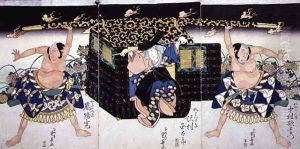Shigeharu Paintings
Shigeharu, born in 1802 in Osaka, Japan, was a notable figure in the world of ukiyo-e, a genre of Japanese art that flourished from the 17th through 19th centuries. Ukiyo-e, or 'pictures of the floating world,' captured the fleeting joys of urban life, including scenes from kabuki theatre, sumo wrestling, and the pleasure quarters. Shigeharu was particularly known for his kabuki prints, which vividly depicted the actors and performances of his time.
Initially working under the name Ryūsai Shigeharu, he was active primarily during the 1820s and 1830s. Shigeharu's work is characterized by its dynamic compositions and vibrant use of color, which brought the theatricality of kabuki to life on paper. He was part of the Osaka School, a group of artists who developed a distinctive style separate from the more well-known Edo (modern-day Tokyo) ukiyo-e artists. The Osaka School's prints are often noted for their realism and attention to detail, qualities that Shigeharu exemplified in his depictions of actors and their elaborate costumes.
Shigeharu's career coincided with a period of significant change in Japan, as the country gradually opened up to the West after centuries of isolation. This era was marked by a mix of excitement and uncertainty, themes that can sometimes be sensed in the dramatic expressions and tense postures of the figures he portrayed. Despite the cultural shifts, traditional kabuki theatre remained a popular subject for ukiyo-e artists, and Shigeharu's work is a valuable document of this important aspect of Japanese culture.
Although Shigeharu's prints were popular during his lifetime, he, like many ukiyo-e artists, faced financial difficulties. The demand for ukiyo-e fluctuated with economic conditions and the changing tastes of art collectors. Shigeharu's dedication to his craft, despite these challenges, left a lasting legacy in the world of Japanese art. He continued to produce work until his death in 1852, leaving behind a body of work that continues to be celebrated for its contribution to the Osaka School and the broader ukiyo-e tradition.
Today, Shigeharu's prints are collected and exhibited around the world, offering insights into the cultural life of 19th-century Japan. His work not only provides a window into the past but also serves as an inspiration for contemporary artists and designers, who draw upon the rich visual language of ukiyo-e. Shigeharu's legacy, like that of many ukiyo-e masters, underscores the enduring appeal of this uniquely Japanese art form.
